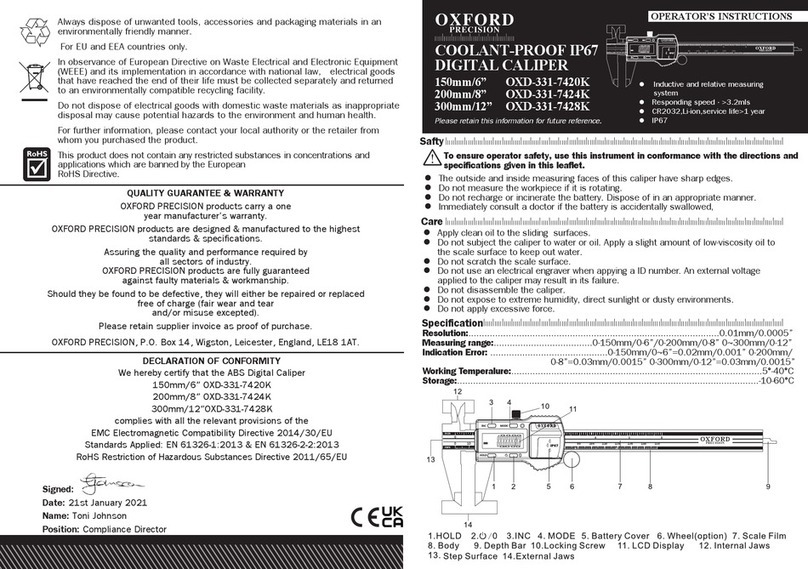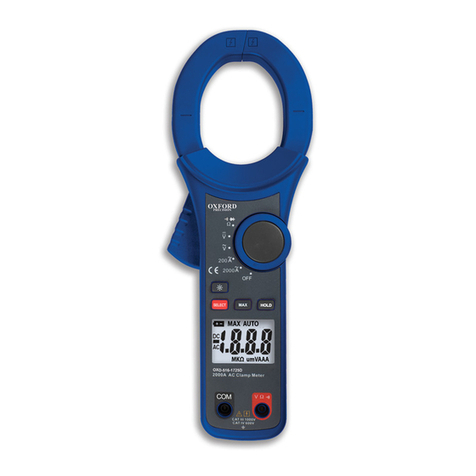
10
MEASURING AC CURRENT
• Insert the black test lead banana plug into the negative COM jack and the red test lead banana
plug into the “uA/mA”or “10A” jack.
• For current measurements up to 4000uA AC, set the function switch to the uA position and
insert the red test lead banana plug into the uA/mA jack.
• For current measurements up to 400mA AC, set the function switch to the mA position and
insert the red test lead banana plug into the uA/mA jack
• For current measurements up to 10A AC, set the function switch to the 10A position and insert
the red test lead banana plug into the 10A jack
• Press the MODE button to indicate “AC” on the display.
• Remove power from the circuit under test, then open up the circuit at the point where you wish
to measure current.
• Touch the black test probe tip to the negative side of the circuit.
Touch the red test probe tip to the positive side of the circuit.
• Apply power to the circuit.
• Read the current in the display.
• Press and hold the Hz% button to indicate “Hz”.
• Read the frequency in the display.
• Momentarily press the Hz% button again to indicate “%”.
• Read the % duty cycle in the display.
• Press and hold the Hz% button to return to current measurement
MEASURING CAPACITANCY
• Set the function switch to the CAP position.
• Insert the black test lead banana plug into the negative COM jack and the red test lead banana plug
into the “V/Hz%/Ω/Cap/°C” jack. (If value is no zero in the display. Press the REL button to zero)
• Touch the test probe tips across the part under test.
• Read the capacitance value in the display.
• The display will indicate the proper decimal point and value.
MEASURING FREQUENCEY
• Set the function switch to the Hz position.
• Insert the black test lead banana plug into the negative (COM) jack
• Insert the red test lead banana plug into the V/Hz%/Ω/Cap/Temp jack.
• Touch the test probe tips to the circuit under test.
• Read the frequency in the display.
• The digital reading will indicate the proper decimal point, symbols (Hz,kHz, MHz) and value.
MEASURING RESISTANCE
• Set the function switch to the
6 in 1 Digital Multimeter User Manual
18
6-11 Measuring Resistance
•Set the function switch to the green Ω position.
•Insert the black test lead banana plug into the negative COM jack.
Insert the red test lead banana plug into the V/Hz%/Ω/CAP/°C jack.
•Indicate “OL” “MΩ” on the display.
•Touch the test probe tips across the circuit or part under test. It is
best to disconnect one side of the part under test so the rest of the
circuit will not interfere with the resistance reading.
•Read the resistance in the display.
6-12 Measuring Diode
•Set the function switch to the green Ω position.
•Insert the black test lead banana plug into the negative COM jack
and the red test lead banana plug into the V/Hz%/Ω/Cap/°C jack.
•Press the MODE button to indicate “ “ and “V” on the display.
•Touch the test probes to the diode under test. Forward voltage will
typically indicate 0.400 to 0.700V. Reverse voltage will indicate “OL”.
Shorted devices will indicate near 0V and an open device will indicate
“OL” in both polarities.
6-13 Audible Continuity Test
•Set the function switch to Ω
position.
•Insert the black lead banana plug into the negative COM jack.
Insert the red test lead banana plug into the V/Hz%/Ω/CAP/°C jack.
•Press the MODE button to indicate“ “ and “Ω” on the display
•Touch the test probe tips to the circuit or wire you wish to check.
•If the resistance is less than approximately 50Ω, the audible signal
will sound. If the circuit is open, the display will indicate “OL”.
6-14 Non-contact AC Voltage Test (NCV)
•Set the function switch to the ON position.
•Remove the meter and face the NCV detector to ACV source.
•If source votalge in 50-1000V the NCV indicate lamp will light.
position.
• Insert the black test lead banana plug into the negative COM jack.
• Insert the red test lead banana plug into the V/Hz%/Ω/Cap/Temp jack.
• Indicate “OL” “MΩ”on the display.
• Touch the test probe tips across the circuit or part under test. It is best to disconnect one side
of the part under test so the rest of the circuit will not interfere with the resistance reading.
• Read the resistance in the display.






























